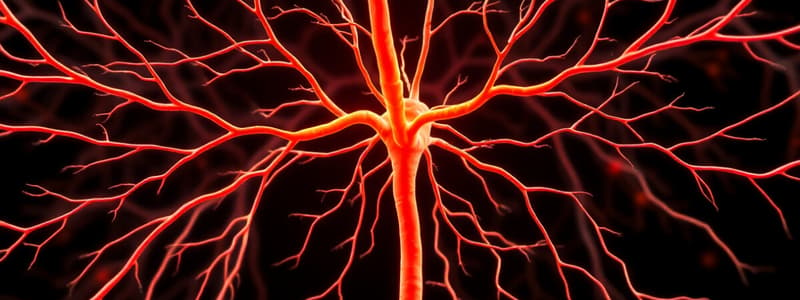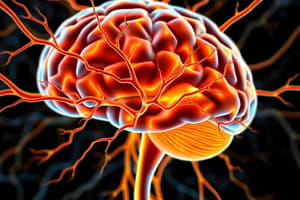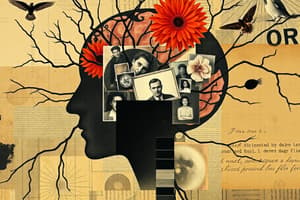Podcast
Questions and Answers
Which part of the neuron is primarily responsible for protein synthesis?
Which part of the neuron is primarily responsible for protein synthesis?
- Myelin sheath
- Cell body (soma) (correct)
- Dendrites
- Axon hillock
What characteristic of neurons allows them to respond quickly to stimuli?
What characteristic of neurons allows them to respond quickly to stimuli?
- High lipid content
- Short lifespan
- Low metabolic rate
- Excitability (correct)
What does the term 'dendrite' refer to in relation to its appearance?
What does the term 'dendrite' refer to in relation to its appearance?
- Branches of a tree (correct)
- Roots of a plant
- Leaves of a flower
- Stems of a shrub
Once mature, what ability do neurons lose?
Once mature, what ability do neurons lose?
Which part of the neuron initiates the electrical charge that leads to signal transmission?
Which part of the neuron initiates the electrical charge that leads to signal transmission?
What percentage of neurons in the central nervous system (CNS) are interneurons?
What percentage of neurons in the central nervous system (CNS) are interneurons?
Which type of neuron is characterized by having no axon and all processes being dendrites?
Which type of neuron is characterized by having no axon and all processes being dendrites?
Which of the following statements about unipolar neurons is true?
Which of the following statements about unipolar neurons is true?
In which location are multipolar neurons most commonly found?
In which location are multipolar neurons most commonly found?
What is the classification for a neuron with two processes extending from the cell body?
What is the classification for a neuron with two processes extending from the cell body?
What is the primary function of the axon in a neuron?
What is the primary function of the axon in a neuron?
Where does the axon begin in a neuron?
Where does the axon begin in a neuron?
What is transported along the axon using molecular motors?
What is transported along the axon using molecular motors?
What are the chemicals called that are released at the axon terminals?
What are the chemicals called that are released at the axon terminals?
What occurs first in the sequence of information flow in a neuron?
What occurs first in the sequence of information flow in a neuron?
What separates the two cells in a synapse?
What separates the two cells in a synapse?
What happens at the axon terminals after the action potential is transmitted?
What happens at the axon terminals after the action potential is transmitted?
Which structure is NOT a part of the axon?
Which structure is NOT a part of the axon?
What is the primary function of the motor division of the nervous system?
What is the primary function of the motor division of the nervous system?
Which subdivision of the nervous system is responsible for subconscious control?
Which subdivision of the nervous system is responsible for subconscious control?
What is the role of neuroglia in the nervous system?
What is the role of neuroglia in the nervous system?
Which division of the peripheral nervous system sends information to the CNS?
Which division of the peripheral nervous system sends information to the CNS?
What happens during sympathetic nervous system activation?
What happens during sympathetic nervous system activation?
Which system is responsible for controlling voluntary movements?
Which system is responsible for controlling voluntary movements?
What effect does the parasympathetic nervous system have on the body?
What effect does the parasympathetic nervous system have on the body?
Which of the following accurately describes the sensory division of the nervous system?
Which of the following accurately describes the sensory division of the nervous system?
What role do oligodendrocytes play in the central nervous system?
What role do oligodendrocytes play in the central nervous system?
How does myelin affect the speed of action potentials?
How does myelin affect the speed of action potentials?
What primarily composes gray matter?
What primarily composes gray matter?
What is a key function of astrocytes in the central nervous system?
What is a key function of astrocytes in the central nervous system?
What type of cells line the cavities of the CNS?
What type of cells line the cavities of the CNS?
What characteristic helps ependymal cells circulate cerebrospinal fluid?
What characteristic helps ependymal cells circulate cerebrospinal fluid?
What is the appearance of areas with high densities of myelinated axons known as?
What is the appearance of areas with high densities of myelinated axons known as?
What do astrocytes connect neurons to for nutrient supply?
What do astrocytes connect neurons to for nutrient supply?
What is the primary function of microglia in the brain?
What is the primary function of microglia in the brain?
What happens to microglia when they sense damage to neurons?
What happens to microglia when they sense damage to neurons?
Which type of neuroglia surrounds the cell bodies of neurons in the peripheral nervous system?
Which type of neuroglia surrounds the cell bodies of neurons in the peripheral nervous system?
How do Schwann cells aid in nerve regeneration in the peripheral nervous system?
How do Schwann cells aid in nerve regeneration in the peripheral nervous system?
What differentiates myelinated axons from unmyelinated axons?
What differentiates myelinated axons from unmyelinated axons?
What effect does incomplete myelination have on infants?
What effect does incomplete myelination have on infants?
In multiple sclerosis (MS), which type of neuroglia is primarily damaged?
In multiple sclerosis (MS), which type of neuroglia is primarily damaged?
What is a major consequence of myelin loss in conditions like multiple sclerosis?
What is a major consequence of myelin loss in conditions like multiple sclerosis?
Flashcards
Nervous System Functions
Nervous System Functions
The nervous system's role involves detecting changes, interpreting them, and initiating responses.
Sensory Division (Afferent)
Sensory Division (Afferent)
Brings sensory information to the central nervous system (CNS).
Motor Division (Efferent)
Motor Division (Efferent)
Carries commands from the CNS to muscles and glands.
Somatic Nervous System
Somatic Nervous System
Signup and view all the flashcards
Autonomic Nervous System
Autonomic Nervous System
Signup and view all the flashcards
Sympathetic Nervous System
Sympathetic Nervous System
Signup and view all the flashcards
Parasympathetic Nervous System
Parasympathetic Nervous System
Signup and view all the flashcards
Neuroglia and Neurons
Neuroglia and Neurons
Signup and view all the flashcards
Neuron structure: Cell body
Neuron structure: Cell body
Signup and view all the flashcards
Neuron structure: Dendrites
Neuron structure: Dendrites
Signup and view all the flashcards
Neuron function: Excitability
Neuron function: Excitability
Signup and view all the flashcards
Neuron structure: Axon hillock
Neuron structure: Axon hillock
Signup and view all the flashcards
Neuron characteristics: Metabolic rate
Neuron characteristics: Metabolic rate
Signup and view all the flashcards
Interneuron function
Interneuron function
Signup and view all the flashcards
Anaxonic neuron
Anaxonic neuron
Signup and view all the flashcards
Unipolar neuron
Unipolar neuron
Signup and view all the flashcards
Bipolar neuron
Bipolar neuron
Signup and view all the flashcards
Multipolar neuron
Multipolar neuron
Signup and view all the flashcards
Axon
Axon
Signup and view all the flashcards
Axon terminal (synaptic knob)
Axon terminal (synaptic knob)
Signup and view all the flashcards
Axon hillock
Axon hillock
Signup and view all the flashcards
Neurotransmitters
Neurotransmitters
Signup and view all the flashcards
Synapse
Synapse
Signup and view all the flashcards
Synaptic cleft
Synaptic cleft
Signup and view all the flashcards
Sensory neurons
Sensory neurons
Signup and view all the flashcards
Motor neurons
Motor neurons
Signup and view all the flashcards
Oligodendrocytes function
Oligodendrocytes function
Signup and view all the flashcards
Myelin's effect on speed
Myelin's effect on speed
Signup and view all the flashcards
Myelin structure
Myelin structure
Signup and view all the flashcards
White matter composition
White matter composition
Signup and view all the flashcards
Gray matter composition
Gray matter composition
Signup and view all the flashcards
Astrocytes' role
Astrocytes' role
Signup and view all the flashcards
Ependymal cell function
Ependymal cell function
Signup and view all the flashcards
Ependymal cells' cilia
Ependymal cells' cilia
Signup and view all the flashcards
Microglia: What do they do?
Microglia: What do they do?
Signup and view all the flashcards
Microglia: What happens when they detect damage?
Microglia: What happens when they detect damage?
Signup and view all the flashcards
Satellite Cells: What do they do?
Satellite Cells: What do they do?
Signup and view all the flashcards
Schwann Cells: What do they do?
Schwann Cells: What do they do?
Signup and view all the flashcards
Myelinated vs. Unmyelinated Axons: What's the difference?
Myelinated vs. Unmyelinated Axons: What's the difference?
Signup and view all the flashcards
Why are infants not as coordinated?
Why are infants not as coordinated?
Signup and view all the flashcards
Multiple Sclerosis (MS): What's damaged?
Multiple Sclerosis (MS): What's damaged?
Signup and view all the flashcards
Why do MS patients lose muscle control and vision?
Why do MS patients lose muscle control and vision?
Signup and view all the flashcards
Study Notes
Nervous System Overview
- The nervous system has three main functions: sensory input (detecting changes), integration (interpreting sensory input), and motor output (controlling muscles and glands).
- The nervous system is divided into two major subdivisions: the central nervous system (CNS) and the peripheral nervous system (PNS).
- The CNS (brain and spinal cord) is the main integration and command center.
- The PNS consists of nerves that carry information to and from the CNS.
Nervous System Subdivisions
- The PNS is further divided into the sensory (afferent) division and the motor (efferent) division.
- The sensory division carries sensory information to the CNS.
- The motor division transmits motor commands from the CNS to effectors (muscles and glands).
- The motor division is further divided into the voluntary (somatic) nervous system, controlling skeletal muscles, and the involuntary (autonomic) nervous system, controlling smooth and cardiac muscles and glands.
- The autonomic nervous system is further divided into the sympathetic nervous system (active during stressful situations) and the parasympathetic nervous system (conserves energy).
Neuronal Structure and Function
- Nervous tissue consists of two main cell types: neurons and neuroglia.
- Neurons are responsible for transmitting electrical signals. They are excitable, have a high metabolic rate, are extremely long-lived, and cannot divide after maturity.
- Important characteristics of neurons include excitability (respond rapidly to stimuli), conductivity (propagate electrical signals), secretion (release neurotransmitters), and longevity (last a lifetime).
Parts of a Neuron
- The cell body (soma) is the central region of the neuron, containing the nucleus and organelles.
- Dendrites are extensions of the soma that receive signals from other neurons.
- The axon is a long projection that transmits signals from the soma to other cells. It begins at the axon hillock.
- Axon terminals are the branches at the end of the axon, releasing neurotransmitters into the synapse.
Synapses and Integration
- Synapses are the junctions between neurons where neurotransmitters transmit signals.
- Information flows in a specific order: dendrites receive signals, the cell body integrates them, the axon transmits the signal as an action potential, and the axon terminals release neurotransmitters.
- Neuroglia (glial cells) provide support and protection to neurons in both the CNS and PNS (e.g., astrocytes, oligodendrocytes, microglia, ependymal cells, satellite cells).
- Schwann cells in the PNS form myelin sheaths around axons, increasing the speed of nerve impulses.
Neuron Classification
- Neurons can be classified functionally (sensory, motor, interneurons) or structurally (anaxonic, unipolar, bipolar, multipolar).
- Interneurons are entirely within the CNS, connecting other neurons and integrating information.
- Sensory neurons transmit signals from sensory receptors to the CNS.
- Motor neurons transmit signals from the CNS to effectors (muscles and glands).
- Structural classifications depend on the number of processes extending from the soma.
Studying That Suits You
Use AI to generate personalized quizzes and flashcards to suit your learning preferences.




